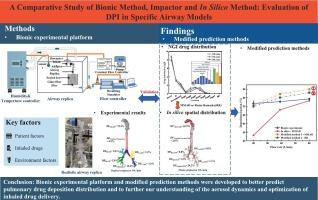A comparative study of bionic method, impactor and in silico method: Evaluation of DPI in specific airway models
IF 4.6
2区 工程技术
Q2 ENGINEERING, CHEMICAL
引用次数: 0
Abstract
The main objective of this work is to develop a novel bionic experimental platform for evaluating orally inhaled drug delivery and to conduct a comparative study among the platform, cascade impactor and in silico methods. A reliable experimental platform fully considering environment, human factors and inhaled drugs was developed to evaluate the pulmonary regional deposition directly. Bionic experimental results were compared to in silico and in vivo data to gain a more comprehensive understanding of their correlation. The findings indicate that inhalation conditions, mouth-throat geometric variation and mass median aerodynamic diameter (MMAD) affected delivery and deposition patterns. Underestimated MMAD obtained by the cascade impactor led to lower in silico MT deposition and discrepancy between bionic experimental and in silico results. Furthermore, modified prediction methods based on cascade impactor and in silico method were proposed to improve the accuracy of prediction results and better consistency was observed by comparing with bionic experimental results. Overall, Bionic experimental platform and modified prediction methods were developed to better predict pulmonary drug deposition distribution and to further our understanding of the aerosol dynamics and optimization of inhaled drug delivery. Bionic experimental platform based on realistic models offers a powerful tool to predict the pulmonary drug deposition accurately and directly prior to in vivo testing. Modified prediction methods can indirectly predict the deposition results based on a combination of cascade impactor and in silico data.

仿生法、冲击器法和计算机模拟法的比较研究:特定气道模型DPI的评价
本研究的主要目的是建立一种新的口服吸入给药的仿生实验平台,并对该平台、级联冲击器和计算机方法进行比较研究。建立了一个充分考虑环境、人为因素和吸入药物的可靠实验平台,直接评价肺区域沉积。将仿生实验结果与计算机和体内数据进行比较,以更全面地了解它们之间的相关性。研究结果表明,吸入条件、口喉几何变化和质量中位气动直径(MMAD)会影响输送和沉积模式。由于级联撞击器获得的MMAD被低估,导致硅中MT沉积量降低,仿生实验结果与硅中结果存在差异。在此基础上,提出了基于级联冲击器和硅法的改进预测方法,提高了预测结果的准确性,并与仿生实验结果进行了比较。总体而言,我们开发了仿生实验平台和改进的预测方法,以更好地预测肺部药物沉积分布,并进一步了解吸入药物的气溶胶动力学和优化。基于真实模型的仿生实验平台为在体内试验前准确、直接地预测肺部药物沉积提供了有力工具。改进的预测方法可以结合串级冲击器和硅数据间接预测沉积结果。
本文章由计算机程序翻译,如有差异,请以英文原文为准。
求助全文
约1分钟内获得全文
求助全文
来源期刊

Powder Technology
工程技术-工程:化工
CiteScore
9.90
自引率
15.40%
发文量
1047
审稿时长
46 days
期刊介绍:
Powder Technology is an International Journal on the Science and Technology of Wet and Dry Particulate Systems. Powder Technology publishes papers on all aspects of the formation of particles and their characterisation and on the study of systems containing particulate solids. No limitation is imposed on the size of the particles, which may range from nanometre scale, as in pigments or aerosols, to that of mined or quarried materials. The following list of topics is not intended to be comprehensive, but rather to indicate typical subjects which fall within the scope of the journal's interests:
Formation and synthesis of particles by precipitation and other methods.
Modification of particles by agglomeration, coating, comminution and attrition.
Characterisation of the size, shape, surface area, pore structure and strength of particles and agglomerates (including the origins and effects of inter particle forces).
Packing, failure, flow and permeability of assemblies of particles.
Particle-particle interactions and suspension rheology.
Handling and processing operations such as slurry flow, fluidization, pneumatic conveying.
Interactions between particles and their environment, including delivery of particulate products to the body.
Applications of particle technology in production of pharmaceuticals, chemicals, foods, pigments, structural, and functional materials and in environmental and energy related matters.
For materials-oriented contributions we are looking for articles revealing the effect of particle/powder characteristics (size, morphology and composition, in that order) on material performance or functionality and, ideally, comparison to any industrial standard.
 求助内容:
求助内容: 应助结果提醒方式:
应助结果提醒方式:


